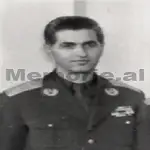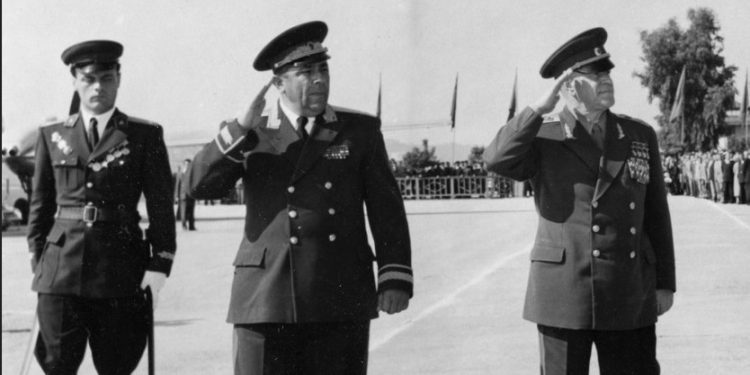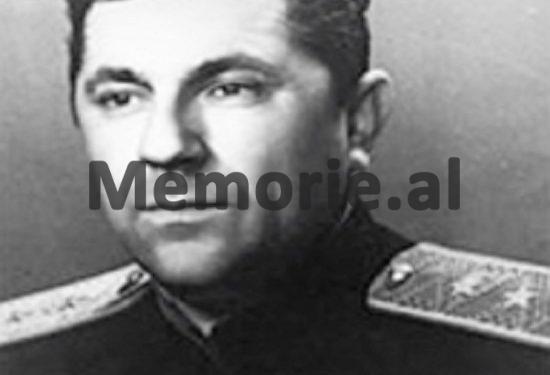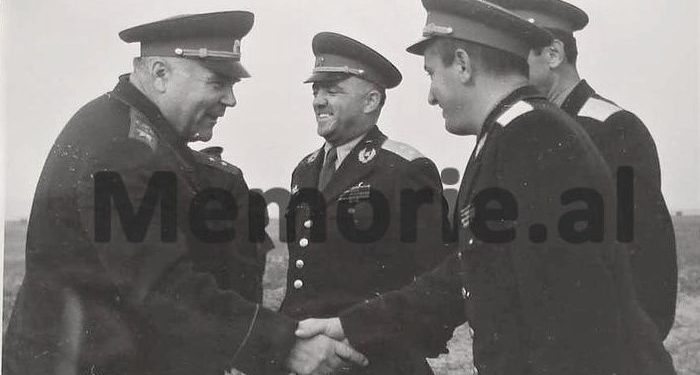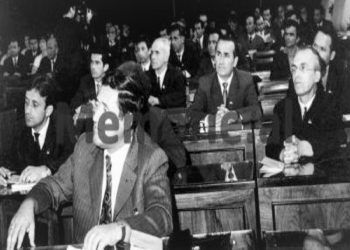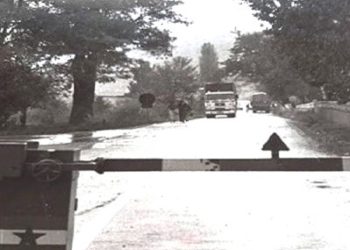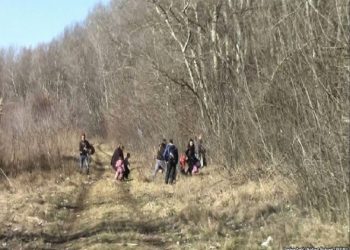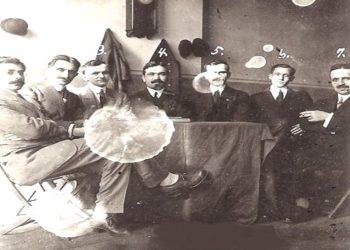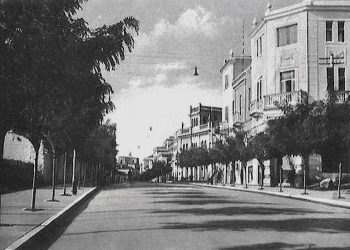By Dr. Etleva SMAÇI
The first part
-The metamorphosis of the “class enemy” in the ranks of the People’s Army, from the “declassed officer” to the “putschist officer and police-agent officer”, in the years 1954 – 1983-
Memorie.al / This paper aims to analyze the metamorphosis of the “class enemy” in the ranks of the People’s Army, in the time period 1954 – 1983. To carry out this comparative analysis, the paper will refer to three important moments, when the Army became a target for the detection and elimination of the professional and, even physical, “enemy”. The People’s Army, during the period of the communist dictatorship, was one of the most important ideological tools in the war against the “class enemy”. And yet it could not escape this “virus”, but on the contrary, it produced its own model of the “class enemy”, which was seen as the main threat to the longevity of popular power and the dictatorship of the proletariat.
The first period, which belongs to the years 1954-1956, is related to the purges that took place in the People’s Army, under the influence of the instructions received from the Soviet Union, to remove from the ranks of the Army, officers with poor class composition. This group included officers who came from families that were considered bourgeois, merchants or beylers. The second period, culminates in the years 1970-1974, when the “class enemies” in the ranks of the Army were considered its highest leaders and were treated as a “coup group” that aimed to weaken the defense of the country, through reactionary theories of the war.
The third period analyzes the “last grouping of enemies” in the ranks of the army, the labeled; “poly-agents”, who “intended to overthrow the communist regime in cooperation with foreign agencies in the 80s, as well as with the former prime minister of the time, Mehmet Shehu”. As in all other fields, even in the ranks of the Army, the attitude towards the “class enemy” had very serious psychological effects, leading to the alienation of the individual, the deformation of reality and, until the creation of a vicious circle that produced absurdity and victims. The difference between the first period and the other two periods is that the enemy was among the “executioners” who ended up as victims.
The concept; “enemy of the people”, borrowed from Stalin’s show trials against the military caste, in the late 1930s, in the Soviet Union, was neatly adopted by the Albanian communist regime and the supporters of Stalinism and found draconian application in the ranks of the military the former National Army first, and then in the ranks of the People’s Army. With the end of the War and the establishment of the communist regime in the country, the Army was openly seen as a “political army” and through it, the principle of “putting proletarian politics in command” was applied, which means that the ideo-political factor had superiority over that military”!
If the policy implemented in the Army was not seen under the prism of Marxism-Leninism, understood differently it would mean that the policy implemented in the Army “was a mistake”.
Viewing the problems in the political and ideological prism could not be done with two positions: “one for the Army and another for the broad masses of the people”.
In this paper, facts will be brought and light will be shed on the documents that have determined the labeling journey; “enemy of the people” in the ranks of the Army. A journey that has known a frightening metamorphosis even within what was considered as; “The most powerful weapon of the Dictatorship of the Proletariat”.
The work stops at three periods of purges of the Army, by “enemies of the people”, which coincide with the savagery of the totalitarian state as a whole and the efforts to maintain power, through the elimination of “enemy groups”, also in the army as in any other area of life. . Platform for cleansing the Army of “undesirable elements”, 1953.
The first period that is taken into consideration is the first 10 years after the war, focusing on the examination of archival documents of the Ministry of People’s Defense, on the purges made by the ranks of the Army, from undesirable elements.
To this period belongs the drafting of the platform of the purges that were initially treated mildly, as “undesirable”, but which essentially cultivated the concept of the enemy and determined the successive eliminations of those who, under certain circumstances, were considered; “enemies of the party and the people”.
In the first decade, emphasis was placed on the social origins of the People’s Army officers (rich peasants, wealthy citizens, merchants), which constituted the axis of the class war. This criterion would serve as a dividing line until the end of the communist regime.
Placed on the platform in 1953, it would reappear wildly whenever the regime needed further eliminations. Four years after the elimination of the “Coup Group” of ’74, on July 10, 1978, in the speech held with students and military personnel, Enver Hoxha would once again return to the idea that; representatives of the rich classes were unacceptable in the ranks of the People’s Army.
“Not even the smallest rich man should be established in the army and our people, and I am convinced that such a thing will not happen, due to the political and ideological education of our entire military people.” They were part of the “army of enemies”, which for the communist leader, were not hypothetical.
“They live, they are standing, they are aggressors. They can attack us with weapons, they can also develop sabotage, they can and do try to corrupt us from the inside”. What exactly were the points of the cleaning platform of 1953?
The first criterion included officers who had participated in organizations opposing the regime, such as the Legality of the ‘Balli Kombëtar’, or officers who had served at the time of Zog and the occupation’ in the ranks of the gendarmerie, carabinieri, police, financial guard, fascist militia’ with the rank of officer or without rank and referred to the platform of the Political Directorate of the Ministry of People’s Defense; “they have fought against our people and other peoples for the interests of the occupiers”.
Officers were no exception here, who “had their relatives exponents of reactionary organizations, state functionaries or, high officers of the Bird Army and the occupiers, who have their people exponents of reactionary organizations and groups, discovered after the liberation and who have their people condemned by the courts as enemies of the people, those whose families have been described as kulaks and have a bad political attitude”, despite their clean attitude.
In this platform, there was no way to miss the old, non-party elite, educated in the West (according to point 3 of the platform, the officer cadre who studied in civil and military schools in imperialist countries, who completed various training courses in these countries, who have completed courses for the police, quaestors, carabinieri, or financial guards), but the same danger is carried by Army personnel who had completed religious studies or served as religious, as well as those who studied in American schools as a technician, in the Agricultural school of Kavaja and in the high school of priests in Shkodër, before the Second World War.
Suspects were also those who had married women of foreign nationality and maintained ties with their families (criterion that would be used for the army’s purge of soldiers with Russian wives, after the break with the Soviet Union, in 1960– of), as well as “those who have worked as translators with official functions, German, Italian, American, English, Greek, Yugoslav, etc., both inside and outside the country.
Who have been cagers, guards, cooks, waiters in foreign embassies and embassies in Albania. Who have served as translators and mediators near foreign missions and organizations, such as; American, English, Italian and others, military or civil as (M.L UNRRA)”.
Since this platform came after the break with Yugoslavia, in the tense and hostile climate between the two countries, it was understandable that within it a special point was placed for “officers who studied in the various military, political or civilian schools in Yugoslavia, those who of the 1st Congress of the KPSH, have had close ties with the Yugoslav envoys to the People’s Army, or with other Yugoslav personnel in Albania and who later showed signs, no matter how small, of a lack of vigilance and loyalty to the party, the people and the Soviet Union (the same argument would be used during ’74 for senior generals who had ties to representatives of the Warsaw Pact and the Soviet Union).
Last but not least for Pasha, to be labeled “enemy of the people”, the platform placed “in a red circle”, through point 6, “those officers who have been interned in concentration camps in Germany, Italy, Greece, and elsewhere, who fell into the hands of the Americans, English, Greeks and cooperated with them, even for a short time, as well as repatriated after the end of the war or, after liberation and for many years have lived in imperialist countries for a long time, but their loyalty has not been proven”.
The Political Directorate of the Ministry of National Defense proposed at the end of this document that; “officers of the mentioned categories, even if they met the conditions to stay in the Army, would not be allowed to work in the Operational Directorate, Organization-Mobilization, Intelligence, Tanks in the Navy, Aviation and depots, in political and cadre bodies” . Based on this document, the Personnel Directorate of the Ministry of People’s Defense drew up without wasting time the name list of 17 officers who, according to the criteria of the platform, did not have political guarantees.
In addition to the list for all 17 officers proposed for release, the archival file also contains the characteristics of each one. It is worth emphasizing the fact that some of the members of the commission were; such as, for example, Petrit Dume, or the president Sadik Bekteshi, who would be victims of the platform drawn up and approved by themselves, in the second and biggest purge of the Army, in 1974.
We think that the list of 17 officers released from the Army is not only interesting for the combination of names according to different criteria, but also for the fact that the vast majority were accepted and kept in the Army, until 1953, not out of good faith, but from being irreplaceable, which the members of the commission do not hesitate to accept, even Enver Hoxha himself, learns of this fact, at the meeting of the Political Bureau, on February 16, 1953.
He states that; the platform is good and its implementation will make the army clean from bad elements. “As for the elements, we will have the opportunity to see them one by one, when they are presented to us for approval.” The other order was related to the fact that the review should be done very carefully and in a secret manner. He addresses Sadik Bekteshi that; when he gathers the commission, tell them that; “only we and the leadership that decided this matter know”.
It seems that the questionnaires that appeared in the biographical notes of the 17 officers proposed by the commission were not a convincing element for the Political Bureau, so they were recommended; “to get experience from those of the Ministry of Internal Affairs, i.e., not to rely on papers, but to investigate outside of the questionnaires that appear in the biographies of these people”.
It seems that the purges became vital, especially after the talks that Enver Hoxha had, in the Commission formed for the purge of the Army officers from elements who do not have guarantees, proposes to release them.
N/Colonel, Filip Cin Geci
Major, Ndoc Shan Luli
First Captain, Teki Hasan Luarasi
First Captain, Qazim Faslli Zylaj
Captain II, Raqi Spiro Pergjika
Captain II, Ali Shuaip Bendo
Captain II, Dragush Hiqmet Delvina
Captain II, Vangjel Mihal Masha
Lieutenant, Anastas Dhimitri Dhimitri
N/lieutenant, Hetem Habil Sulo
N/lieutenant, Bektash Arif Muhameti
N/lieutenant, Selman Abaz Karoshi
N/lieutenant, Sabah Xhemal Mece
N/lieutenant, Mahmut Vehap Perllaku
N/lieutenant, Dhori Naun Shore
Aspirant, Ramiz Asllan Fejzullaj
Civil, Thoma Plasa
Although there are no archival documents to show the connection between this platform and the criteria that Stalin followed, for the cleansing of the Red Army from the “enemy” element, with the great trials of 1937-’38, some similarities are very visible. Let’s list some of them. First, in the ranks of the Red Army, there were a number of officers who had served in the tsarist regime and had become part of the Red Army during the civil war in 1920, due to being experts. But they were considered as; “internal enemies”.
Second, the former White Guards, who had fought the Bolsheviks. Thirdly, the “military in the service of foreign agencies”, who had connections with the Germans, the British, the Japanese, the Poles, etc. Fourth, the soldiers who came from the rich peasant classes. Their loyalty to the regime always remained questionable. It seems that these criteria were very appropriate to create the typology of enemies in the ranks of the Albanian Army. Typology of 17 “enemy” officers. For the names of the nominal list, we can make a classification as follows:
a) Necessary
This group included lieutenant colonel Filip Geci, major Ndoc Luli and captain Qazim Zylaj, where it was emphasized that; “these would be excluded from the Army, as undesirable elements, in case they were replaced”. The three soldiers were part of the Geodesy section, in the Ministry of National Defense, with the profession of surveyor.
All three were called to the ranks of the People’s Army after 1945 and were tasked with carrying out only technical work, in the absence of trusted people. Their release was requested because “now our Army has cadres with political guarantees and trained in the schools of the Soviet Union, for military topography, so his replacement is possible. The commission proposes shooting in release”.
Based on the criteria of the platform, they fulfilled several points such as: education in military schools abroad, they had served as officers in Zog’s army, in the occupying armies. All three of them, according to the characteristics prepared by the commission, did not like the People’s Army and rather hindered the work and damaged it and did not give any guarantee to work in the Army.
In the characteristic of Ndoc Shan Luli, the fact that he; “even hoping for a change in the situation”, while for Qazim Zylajn, the biographical notes are even darker. The suspicions about him were even greater because, very close to his family, they were sentenced to life imprisonment (his cousin, Rasim Zyla), the same is said about his wife’s family circle, where there were several convicts with life imprisonment or, who had died in prison. (Isuf Hysenbegasi, Faik Hysenbegasi, etc.).
It is described as; “an old officer who hates the government and the People’s Army and is affected by the reforms, like him and his wife. But his work is classified as very bad, he doesn’t work, he doesn’t prepare. Unsatisfied, he whispers and associates with enemy elements”. These three names became the subject of discussion at the meeting of the Political Bureau on April 20, 1953. In his speech, Mehmet Shehu stated that; “As for the three surveying officers, they would be retained if no replacement cadres were found”, adding that; “we know who they are”!
He even predicts their future. “If we have cadres and can replace them, then send them to construction.” Enver Hoxha’s intervention arouses interest, revealing the essence of why these officers had escaped the class purges. “I agree with Mehmet, in case they are irreplaceable. Then it should be taken into account that we don’t put these people in prison after two months, but let them get to work, work, because they are experienced people”.
Declassified military doctors
The three military doctors, who are on the list of purges, are undoubtedly huggers of the wealthy classes of Albanian society, from the pre-war period. They are; Ali Shuaip Bendo, Dragush Hiqmet Delvina and Vagjel Mihal Masha. All three doctors are characterized as wealthy citizens, or of noble origin.
They are also accused of being representatives of the reactionary classes, whose assets have been nationalized, descendants of high-ranking officials, as was the case of Dragush Delvina, the son of the Minister of Justice Hiqmet Delvina, or family ties to immigration, as is said about the doctor Vangjel Mihal. Masha (Maintains regular correspondence with brother in Australia).
All three are described as working little and out of fear; “he can harm us and fight at any moment”. “As a ward doctor, ay can at any time serve the enemy, with any kind of information, on the state of health and morale – political, military and material of the ward.
From the data of the document, it appears that Ali Shuaip Bendo was the only one who had dared to ask to leave the Army, and even made 8 prayers. While Dragush Delvina, was accepted as a military doctor, with the rank of lieutenant, in 1947. He was imprisoned in the period 1947-1949, accused of hostile work, but was released as innocent.
It is said in the characteristic that “he hates power. Keeps contact with enemy elements. In the military-political work, which is done in turnips, it appears weak. From the military point of view, it is very weak”. Memorie.al
Lecturer at the Academy of the Armed Forces, Department of Strategy and Military History
The next issue follows




